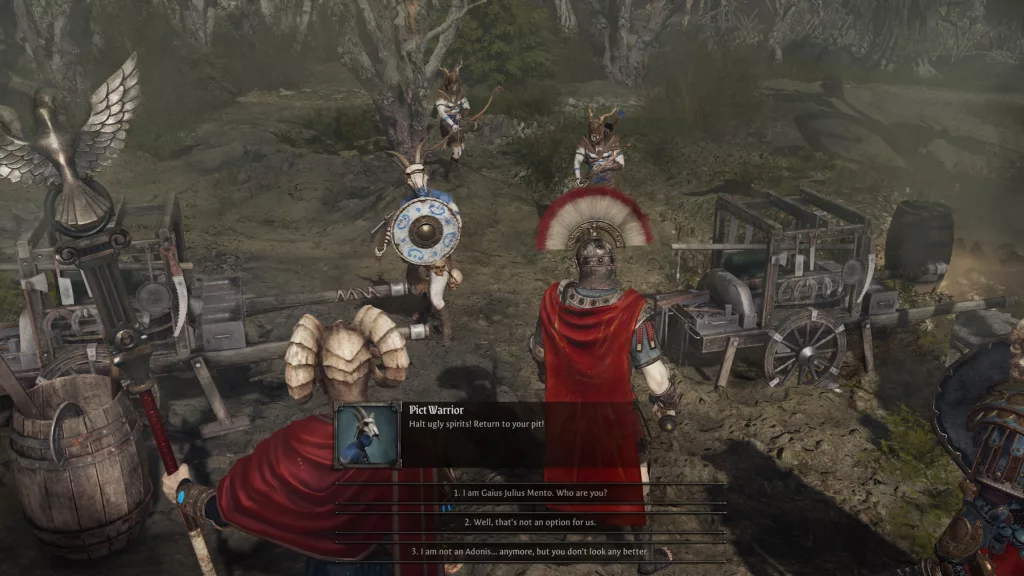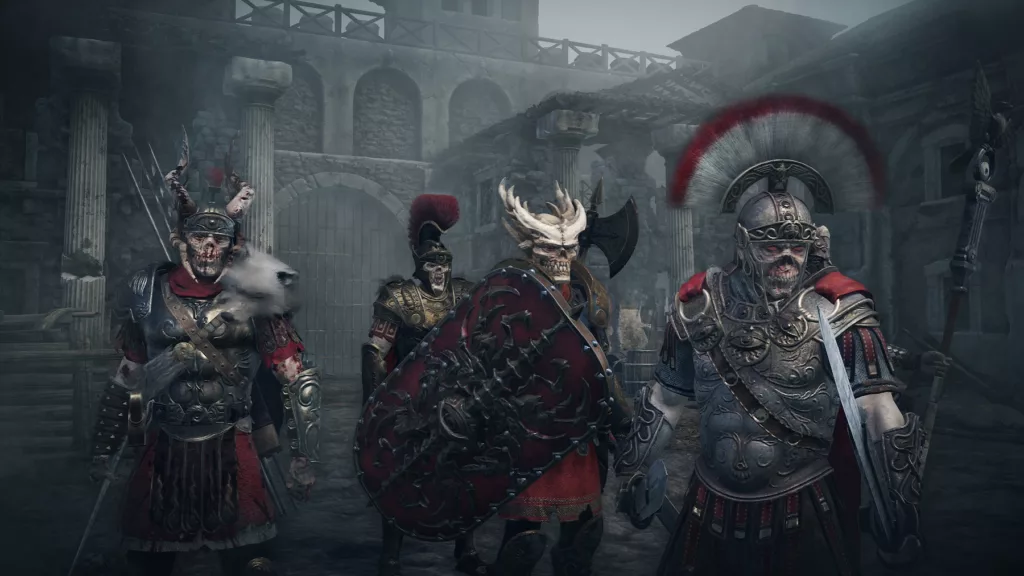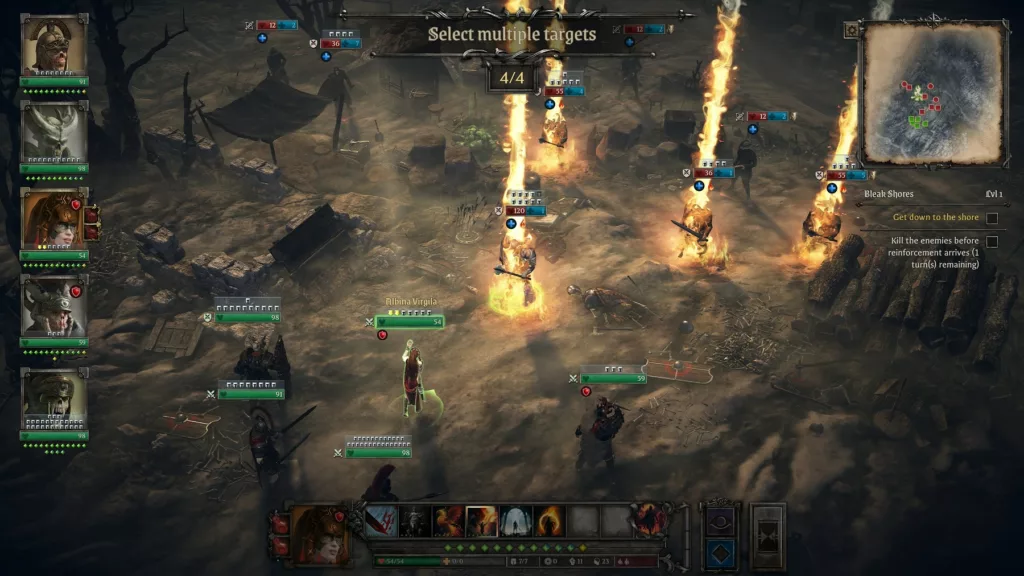The mists of Avalon part as Gaius Julius Mento draws his sword, flanked by his grim band of undying legionnaires. Once loyal soldiers of Rome now cursed to walk the twilight lands between life and death, their armor bears the scars of past battles. Led by the fierce Tribunus Mento, they must rebuild their strength and summon new allies to challenge the powers holding them in this purgatorial realm.
Mento’s quest takes him from the marshes to the fortressed hills as he works to establish a foothold for his Eternal Rome. In time, this seed would grow into the colonial outpost of Nova Roma. But hostile forces lurk in the mists, and Arthur and his knights are said to defend this otherworld against invaders. Through battles both strategic and moral, Mento must bolster his command if any hope remains of restoring the Ninth Legion to glory, or earning their final release to the afterlife denied them.
It is in this mystical land that I join Mento and his legionnaires, having not experienced the original King Arthur: Knight’s Tale but drawn to the promise of tactical combat in a setting that blends history and myth. My Latin may be rusty but Caesar always found a way to prevail through discipline and daring. Let us see if this resurrected Roman and his ghostly garrison can do likewise against the powers of Avalon.
Creating Eternal Rome in the Mists of Avalon
The mysterious realm of Avalon provides a captivating setting for King Arthur: Legion IX. As Tribunus Gaius Mento, you find yourself resurrected among the spirits of Rome’s IX Legion in this strange land between life and death. A curse binds your souls to continued existence, neither living nor dead.
Mento’s task – and yours – is to rebuild the strength and glory of the Eternal Empire amid Avalon’s foggy domains. With your immortal legionaires at your side, you establish the outpost of Nova Roma and explore Avalon’s wilderness. Within these mists lurk both allies and enemies. Pict tribes and deadly spirits inhabit the land, while lingering remnants of past Roman incursions also roam. Arthur and his knights defend Avalon, and determining whether to challenge or ally with Camelot falls to the choices you make.
Navigating the perils of Avalon, you develop your characters through combat and progression systems. Each member of the IX Legion possesses unique abilities to support varied playstyles. Positioning and coordinated use of skills prove vital against the many foes you face. Resolving encounters rewards experience to improve your characters and Nova Roma.
Choice further shapes your campaign through a morality system. Will you embrace your demonic curse, giving in to brute force? Or strive for humanity through mercy and cooperation? Consequences follow either path, impacting relationships and dialogue. Maintaining loyalty offers battle benefits, while disloyalty weakens performance.
While story and character development could offer more depth, the premise captivates. Set amid Celtic myth and Roman history, Avalon brings these realms together imaginatively. Environments convey a haunting atmosphere, drawing you into the RPG experience. Narrative strengths include meaningful choice and consequence. Though brevity limits investment, the framework supports strategic gameplay at the heart of King Arthur: Legion IX.
Rebuilding the Legion Through Strategy
Within the mists of Avalon, strategy and careful planning are required to rebuild the fallen Legion. At its core, King Arthur: Legion IX employs intuitive turn-based combat where players control a party of up to five Roman soldiers, each with unique abilities.
During battles, characters are limited by action points that replenish each turn. Players must carefully consider mobility, attacks, and special skills when facing waves of enemies on varied maps. Positioning is important, as positioning allows characters to flank opponents or seek advantage from terrain features.
The variety of character classes ensures there are roles for all playing styles. The Shieldbearer tanks damage with armor and barrier skills. Ranged attackers like the Javelineer pick off threats from afar. Meanwhile, spellcasters including the Pyromancer deal area damage and support allies with healing. As characters progress, players can specialized them through skill trees focusing on different combat niches.
Beyond turn-based clashes, players spend time between missions improving their cadre. A loot system rewards new weapons and armor with distinct stats for customizing builds. At the settlement of Nova Roma, resources and upgrades are applied to expand defensive capabilities and bolster comrades. These additions are incremental yet impactful, strengthening the Legion for future fights.
While city development could offer deeper mechanics, managing Nova Roma and outfitting companions remains engaging. Where some find the difficulty spikes punishing and story beats uneven, the satisfying core of tactical battles and building personalized squads of Roman soldiers is enthralling enough to keep players engaged in the campaign to escape Avalon. Through careful strategy and progressive upgrades, the shattered remnants of the Ninth Legion can be rebuilt to face any challenge in this mysterious supernatural realm.
Holding the Line With Strategic Combat
At the heart of King Arthur: Legion IX lies its tactical combat. Players maneuver characters across gridded maps, spending action points to strike foes or use special skills. Positioning proves pivotal – characters can flank opponents from behind to deal extra damage or seek shelter in cover to avoid ranged attacks. With careful planning, sizable enemy waves can be overcome.
Each of the six party members brings a distinct ability set. The Shieldbearer absorbs harm with barriers as the Flame Priestess rains fiery ruin upon clusters of enemies. Meanwhile, the Javelineer pick off threats from afar. By leveling up, additional perks enhance these roles into customized combat builds.
Coordinating characters’ synergistic skills across turns results in satisfying strategic victories. The Pyromancer can link two targets, copying burn damage between them. Perfectly timed, this allows thinning massive groups through flames alone. Diverse encounter arenas from marshes to ruins encourage creative application of strengths.
Overall, the game aims to challenge without feeling unfair. Normal difficulty provides openings for experimenting with approaches. Yet higher settings reward careful consideration through tough but surmountable missions. This helps maintain enjoyment as superior tactics emerge.
However, some later impediments undermine an otherwise compelling flow. Restricting party sizes weakens invested builds arbitrarily. Meanwhile, a few caustic encounters overload defenses despite prior established difficulty curves. While specialization and preparation usually prevail elsewhere, these outliers barrage defenses relentlessly with unpredictable shocks.
Despite uneven spikes, King Arthur: Legion IX conquers as a strategic experience. Sound mechanics reward mastering each hero’s unique abilities together. With smooth balancing elsewhere, refining restriction issues could strengthen an already enthralling system for tactical purists.
Cinematic Scope Hampered by Rough Edges
King Arthur: Legion IX boasts some impressive production values in its graphics, even if rough patches dampen the experience at times. Character models shine, capturing the gritty detail of armored Roman legionnaires infused with demonic essence. Clever animations bring abilities like summoning fire hawks vividly to life.
Environmental backdrops also dazzle. From dusty frontier settlements to misty magical forests, each locale feels alive. Subtle touches, like riders on a distant road or birds circling the trees, further the illusion. Technical feats like reflective water are especial standouts. Dynamic lighting and weather effects heighten immersion.
Regrettably, smooth visuals give way to jarring issues at story beats. Stilted dialog scenes see characters literally bumping into one another. Textures blur closely, while framing awkwardly cuts people off at the edges. It seems final polishing fell by the wayside.
Sound fares better, though not without faults. Combat fills with metal clashing and magic crackling. Tense strings swelling in pivotal moments rouse cinematic feeling. Atmospheric ambience from chirping crickets to haunting winds envelopes you in each realm.
Yet voice acting proves a weak point. While main cast efforts suffice, extras recite lines without conviction. Technical flaws like audio failing to sync up pull one from the story. Despite effort, dialog falls flat far too frequently.
Overall, Legion IX strives for blockbuster presentation. Its artistic merits shine through vivid creature design and spellbinding vistas. However, unfinished edges prove distracting, disrupting otherwise engaging cutscenes. With polish, this proven visual style could truly sing. As is, rough patches inevitably surface amidst impressive achievements, hampering overall experience. Potential exists for Neocore to smooth over inconsistencies in future works.
Return to the Ninth Legion
King Arthur: Legion IX provides a fairly accessible experience, though it may not have tremendous longevity for some. Systems like movement and combat unfold logically thanks to clear tutorials. Difficulty choices span several levels too, ensuring a challenge for all tactical tastes. Yet aspects like permanent character upgrades don’t lend themselves to replay value down the line.
The game introduces players to its world and mechanics at a gentle pace. Early missions place gentle limitations while exposing core concepts. Objectives stay straightforward, avoiding punishing complexity. More intricate systems involving skills and gear unfold segment by segment. This gradual incline proves smooth, allowing players to acclimate comfortably before tackling weightier material.
Customization exists via five difficulty presets. ”Recruit” smooths out tactics for newcomers, while ”Veteran” and beyond amp up enemy mechanics and consequences. This provides a means for all players to tailor engagement to their strategic preferences or group. Messages also address permanence up front, avoiding disappointment down the line.
Sadly, resets lack substance once end credits roll. A New Game+ mode exists, but players inherit extensive upgrades, undermining any sense of progression. While some may relish refining optimized builds, the opportunity to experience tailored narratives or reimagined encounters goes untapped. Similarly, branching choices don’t alter maps or gameplay, lessening incentive to diversify decisions.
All told, the Ninth Legion offers a slick and satisfying tactical campaign. But for some, a single stratagem may not prove as gripping long-term without systems enabling fresh journeys. The legions hold value in their solid realization and customization alone. Yet for prolonged strategizing, ambition for new conquests risks growing stale without levers granting novel reinventions of Avalon and its pixie-plagued populace.
Beyond the Ninth Gate
King Arthur: Legion IX offers an intriguing premise and satisfying combat, though some stumbles keep it from full victory. The strength of facing mythic foes as cursed Roman soldiers can captivate history and fantasy enthusiasts alike. A fun cast of characters and rich customization add much to tactical missions. But rough edges in production values and late game difficulty spikes lessen the experience some.
The game world excels in immersing players in its vision of Avalon. Fans of tales blending eras and legends may find much here to admire. Those seeking challenge in strategy will also find enjoyment mastering abilities against tough odds. Where the narrative goes unsatisfying at times, combat and character progression prove highly engaging. With a few polishes to balancing and technical elements, future entries could ascend to new heights.
Still, Neocore shows skill at worldbuilding and mechanics that make for an adventure well worth seeing through to its conclusion, flaws notwithstanding. While some may wish for looser restrictions or a more epic conclusion, the Ninth Legion delivers entertainment through grim determination.
Their mission brings both satisfaction and fuel for imagining journeys still to come. For those who would march with the cursed Romans into fresh mythic battles, King Arthur: Legion IX offers a proven foundation to build upon. Their saga in Avalon may end, but hope remains for new fields to conquer beyond the ninth gate.
The Review
King Arthur: Legion IX
King Arthur: Legion IX shows flashes of brilliance amid rough edges in need of sharpening. Its compelling setting and satisfying tactical combat carry the day, offset somewhat by an underwhelming conclusion and late game challenges better balanced. With potential demonstrated here, renewed focus on quest design, storytelling and stability could see Neocore's vision for fantastical Romans in Avalon reach new heights. The game gets points for its solid core systems and intriguing premise, however issues with difficulty spikes and technical troubles hold it back from greatness. With improvements to balancing, narrative cohesion and polish, future outings for the Ninth Legion could storm field and frontier alike. As is, it offers an entertaining strategy adventure likely to please fans of the genre and history-meets-fantasy tales.
PROS
- Engaging turn-based combat system
- Deep character progression and customization options
- Atmospheric setting blending Roman history and Arthurian legend
- Strong sense of unique party roles in battles
- Satisfying to gradually improve characters and weaponry
CONS
- Underdeveloped main plot and characters
- Late game encounters have excessive difficulty spikes
- Performance issues like frequent crashing and bugs
- Low enemy variety across many similar maps
- Missed opportunity for more impactful choices





















































